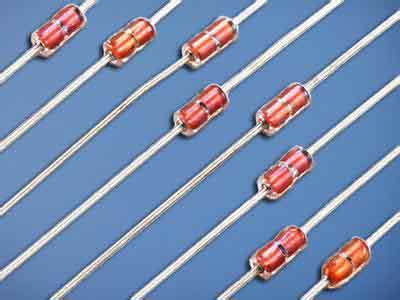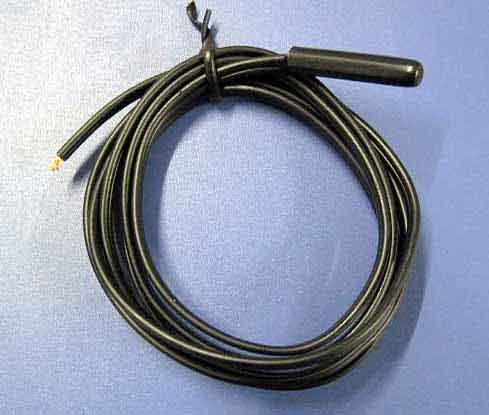NTC PTC Thermistor Symbol & Formula
Experiments show that, within the operating temperature range, the resistance-temperature characteristics of the PTC thermistor can be approximated by the experimental formula:
RT=RT0 expBp(T-T0),
In the formula, RT and RT0 represent the resistance value when the temperature is T and T0, and Bp is the material constant of the material.
NTC thermal semiconducting ceramics are mostly oxide ceramics with a spinel structure or other structures, which have a negative temperature coefficient, and the resistance value can be approximately expressed as:
Rt = RT *EXP(Bn*(1/T-1/T0)
In the formula, RT and RT0 are the resistance values at temperature T and T0, respectively, and Bn is the material constant. The resistivity of the ceramic grain itself changes due to temperature changes, which is determined by the characteristics of the semiconductor.
Barium titanate crystal is a perovskite type structure, which is a ferroelectric material, and pure barium titanate is an insulating material. After adding trace rare earth elements to the barium titanate material, after proper heat treatment, the resistivity sharply increases by several orders of magnitude near the Curie temperature, resulting in the PTC effect. This effect is related to the ferroelectricity of BaTiO3 crystal and the phase transition of the material near the Curie temperature. Barium titanate semiconducting porcelain is a polycrystalline material, and there are inter-grain interfaces between the grains. When the semiconducting porcelain reaches a certain temperature or voltage, the crystal grain boundary changes, and the resistance changes sharply.
The PTC effect of barium titanate semiconducting porcelain originates from grain boundaries (grain boundaries). For conducting electrons, the interface between grains is equivalent to a potential barrier. When the temperature is low, due to the action of the electric field in the barium titanate, the electrons can easily cross the barrier, and the resistance value is small. When the temperature rises to near the Curie point temperature (that is, the critical temperature), the internal electric field is destroyed, and it cannot help the conductive electrons to cross the barrier. This is equivalent to an increase in the potential barrier and a sudden increase in the resistance value, resulting in the PTC effect. The physical model of the PTC effect of barium titanate semiconducting porcelain: a model with a surface barrier. The barium absence model and superimposed barrier model of Daniels et al. They provide reasonable explanations for the PTC effect from different aspects.



RT=RT0 expBp(T-T0),
In the formula, RT and RT0 represent the resistance value when the temperature is T and T0, and Bp is the material constant of the material.
NTC thermal semiconducting ceramics are mostly oxide ceramics with a spinel structure or other structures, which have a negative temperature coefficient, and the resistance value can be approximately expressed as:
Rt = RT *EXP(Bn*(1/T-1/T0)
In the formula, RT and RT0 are the resistance values at temperature T and T0, respectively, and Bn is the material constant. The resistivity of the ceramic grain itself changes due to temperature changes, which is determined by the characteristics of the semiconductor.
Barium titanate crystal is a perovskite type structure, which is a ferroelectric material, and pure barium titanate is an insulating material. After adding trace rare earth elements to the barium titanate material, after proper heat treatment, the resistivity sharply increases by several orders of magnitude near the Curie temperature, resulting in the PTC effect. This effect is related to the ferroelectricity of BaTiO3 crystal and the phase transition of the material near the Curie temperature. Barium titanate semiconducting porcelain is a polycrystalline material, and there are inter-grain interfaces between the grains. When the semiconducting porcelain reaches a certain temperature or voltage, the crystal grain boundary changes, and the resistance changes sharply.
The PTC effect of barium titanate semiconducting porcelain originates from grain boundaries (grain boundaries). For conducting electrons, the interface between grains is equivalent to a potential barrier. When the temperature is low, due to the action of the electric field in the barium titanate, the electrons can easily cross the barrier, and the resistance value is small. When the temperature rises to near the Curie point temperature (that is, the critical temperature), the internal electric field is destroyed, and it cannot help the conductive electrons to cross the barrier. This is equivalent to an increase in the potential barrier and a sudden increase in the resistance value, resulting in the PTC effect. The physical model of the PTC effect of barium titanate semiconducting porcelain: a model with a surface barrier. The barium absence model and superimposed barrier model of Daniels et al. They provide reasonable explanations for the PTC effect from different aspects.








